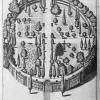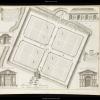Oxford Physick Garden (1621)
Commentary
Founded by the endowment of the nobleman Henry Danvers in 1621, the Oxford Physick Garden was the first of its kind in England. While there is no surviving record as to why Danvers endowed the Garden, as was the case with most early botanical gardens, the Oxford Physick Garden served as a location for the university's medical education throughout its early years.
While intended to serve as a ‘Nursery of Simples’, under its early caretakers, Jacob Bobart the Elder and Jacob Bobart the Younger, the Oxford Physick Garden grew a variety of medicinal herbs, fruits, vegetables. The Garden’s layout reflected the horticultural fashion of period, arranged in geometric shapes and divided by decorative hedges. In addition to raising plants native to Europe, The Bobarts used stove houses to cultivate flora gathered abroad. At its peak, the early modern garden contained nearly 900 exotic specimens, including pineapples, coffee, and sugar cane.
From its founding, the Garden was central to botanical activity in early modern England. Its caretakers corresponded with leading naturalists of the period, including Hans Sloane and William Sherard, and even hosted a visit from Carl Linnaeus in 1736. Plants from the Garden were used as the basis for Robert Morison’s Plantarum historiae universalis Oxoniensis, one of the most significant early works published by the Oxford University Press. The Garden also regularly produced printed catalogues of its plants and seeds to promote sales to contemporary botanists (image 2).
Commentary: Madeline White (April 2022)




